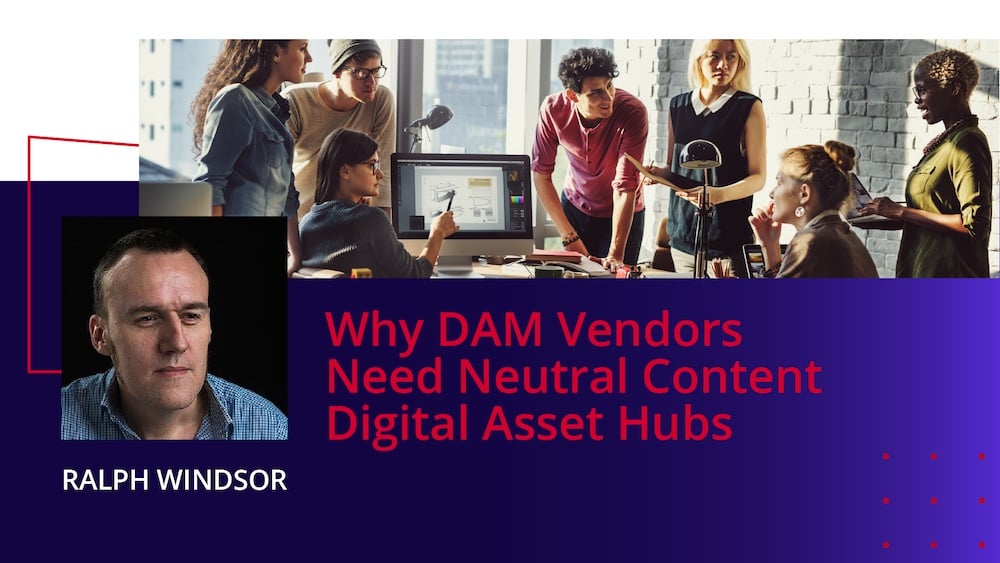
August 26, 2022
Why DAM Vendors Need Neutral Content Digital Asset Hubs
Since the beginning of the 21st century, the value of data (and the collection of it) is now recognised and accepted as an integral feature of modern operations management principles and practices. Most businesses have gone through some form of digital transformation, regardless of whether their actual end product or service is digital in nature.
Alongside this, awareness of the Digital Asset Supply Chain has also increased. For businesses to survive and remain competitive in such a fast moving landscape, they will need to embrace new technologies and realise that the data that passes through their systems is often transient – it is on a journey, perhaps from a photographer to a marketing department, and onwards to a retailer.
Gone are the days of siloed information and proprietary, ring-fenced systems. The need for an open approach to data and digital assets is nowhere more apparent than in the DAM ecosystem. Users expect to be able to not only access their media files, documents and files from a central location, but for them to be accessible to any number of upstream or downstream applications and service partners.
Although many DAM vendors are actively developing and promoting the integration features of their platform by offering connectors for a growing number of third-party applications including creative, marketing, eCommerce and CRM platforms, the truth is that the average user will still be using more than one digital asset repository.
Common workflow scenarios often include a cloud storage solution like Dropbox, Box or Google Drive. Many still use corporate network shared drives (and in some cases very rudimentary approaches like email attachments). This is far from ideal and leads to a fragmented digital asset supply chain. An analogy for this state of affairs might be a restaurant menu stating that "the croissants are on the way from the bakery", or "the salmon hasn't been caught yet". Customers expect businesses to have their digital and physical supply chains aligned without them having to give a second thought to how any of the minutiae of it occurs. These are ‘maintenance’ attributes that only get mentioned when expectations fail to be satisfactorily met.
Even with a well-connected DAM system, the ‘single source of truth’ mantra only applies to the central DAM, whereas in reality there is likely to be numerous sources, each with their own digital asset repository (e.g. PIM, CMS, stock media libraries etc.) that need to be logged into in order for the appropriate files to be discovered, reviewed, downloaded and passed along the chain. Unless your business is operating in a vacuum, the need for a platform-agnostic hub to consolidate and serve up assets from multiple supply chain sources rapidly becomes an obvious problem that simply has to be solved.
One Size Fits No one
Until now, the trend in the DAM sector has been to provide a one-size-fits-all model: instead of streamlining the digital asset supply chain workflow, by attempting to both cater for everyone and lock users into their product, vendors have invariably made it more complex by introducing all manner of niche features that are rarely, if ever, utilised.
The core functionality of most DAM systems has changed very little over the last twenty years – upload, ingest, tag, catalogue and distribute. Although the advent of software integrations and connectors have undoubtedly been a benefit for those who wish to access digital assets without leaving their existing application (e.g. Photoshop or InDesign), the elephant in the room is one of grossly inefficient interoperability. In simple terms, the digital assets are too tightly bound to the DAM system they originate from. This is compounded by the fact that many large enterprises are unwitting users of multiple DAMs without even realising it.
What if I wanted to reuse an image from my stock library account, modify a promotional video that a service partner has uploaded to their own DAM system or include a photo of my employer’s CEO that is held within our enterprise DAM? I don’t care that vendor X who developed the stock media library has an amazing user experience or that vendor Y who supplies the enterprise DAM has a highly scalable media delivery infrastructure. These are isolated benefits which pale by comparison to my main problem: the need to login, download and log out of one, two, three, four or more of them within a short space of time. This is what kills my productivity and bleeds the potential ROI I can obtain from Digital Asset Management, in the wider sense of that term. This is what is at the root of why so many DAM users are only partially engaged with them and why they often prefer to download collections to the desktop of their workstations, put them on memory sticks, store them in Dropbox folders or email zip files to colleagues outside (or inside) the organisation. If you are a DAM vendor and you care about the ROI users can generate from using solutions you provide, you need to see the bigger picture. Any vendor who can’t (or won’t) see this has effectively consented to their own obsolescence and, ultimately, their commercial extinction.
The Vendor Neutral Digital Asset Hub
To be able to provide true content integration, DAM vendors need to address the friction that arises from the problems outlined above, namely the issue of bridging the workflow gap between multiple digital asset supply chain storage repositories and attempting to unify access to digital assets regardless of the DAM, MAM, BAM, PIM, CMS or cloud storage platform that houses them.
The obvious solution is an intermediary that is capable of drawing in assets from multiple locations. Instead of a DAM system attempting to connect to multiple digital asset repositories, a third-party digital asset hub would turn this approach on its head by allowing the user to open up their chosen software (e.g. Adobe Creative Suite, WordPress, Microsoft 365) and tap into multiple DAM systems, cloud storage providers, and third-party services. This 'octopus' approach, although conceptually similar to implementing multiple DAM integrations, has one major difference: the DAM system is no longer regarded as the single source of truth and instead becomes just another file repository, or content satellite, in a wider digital asset ecosystem that has the ability to access numerous other such sources.

Without a third-party, platform-neutral digital asset hub, DAM vendors are effectively isolating their systems from the wider digital asset supply chain and ring-fencing their client’s digital assets therein. Without such a hub facilitating access to multiple digital asset sources, users are required to log into any number of different systems, which in turn can lead to a disjointed workflow, and ultimately, reluctance to use the DAM system. This makes it far more likely for users to revert to far less feature-rich solutions such as Google Drive, Box or Dropbox. DAM vendors are always keen to point out the benefits of their platforms to the aforementioned simple file management solutions. But if they are not connected to vendor-neutral hubs, their advantages diminish, as does the ROI their users can gain from their products.
Although there have been some attempts to kick-start DAM interoperability initiatives, progress in terms of cross-platform integration has been slow. A growing number of vendors now claim that their platforms conform to the API-First (or ‘headless’) model, although this rarely translates to improvements in integration or performance in the real-world. It often requires system administrators to have quite a high level of technical skill in order to leverage the API's features.
To some extent, the reluctance of vendors to open up access to their platforms is understandable; aside from security, which is always going to be a high priority concern, vendors need to protect their USPs (of which there are now very few in such a homogenised sector), and in an increasingly crowded and competitive industry, an unwillingness to play with others is perhaps to be expected.
No DAM is an Island
In order to keep up with the explosive growth and ever pervasive nature of digital content, the role of DAM will need to evolve beyond a standalone system that merely curates and delivers digital assets to a select group of users. Consumers and creators of digital content now expect to be able to access the assets they need, on demand, regardless of where the files reside and which platform they are using. The idea of vendor-neutral hubs that can standardise the process of accessing and interacting with digital assets, irrespective of their location, is a likely candidate for the next step in this evolution.
DAM vendors are now at a crossroads. If they choose to continue along their current path, they face the risk of their platforms being relegated to legacy maintenance systems, with limited access to the assets therein. The alternative route is one of acceptance – that no DAM is an island, and in order to provide freedom of movement for their users' digital assets, they must attempt to see the bigger picture in terms of the digital asset supply chain and the potential benefits of reducing the bottlenecks that their users are facing when working across multiple systems.
The use of vendor-neutral content digital asset hubs may ultimately push DAM systems into the background as the interface which users physically interact with. Such acquiescence and reduced visibility should not be seen as demotion, however. The DAM (or ‘their DAM’ from the vendor’s perspective) will still remain as a source of truth. By acknowledging the practical reality that their end-users face, i.e. that there are going to be multiple sources of digital assets used by their clients, vendors are far more likely to retain their current positioning and be able to extend their influence as and when further opportunities present themselves.
About the author
Ralph Windsor is Project Director of DAM Consultants, Daydream and Editor of Digital Asset Management News.

Article by
Ralph Windsor
Ralph Windsor is Project Director of DAM Consultants